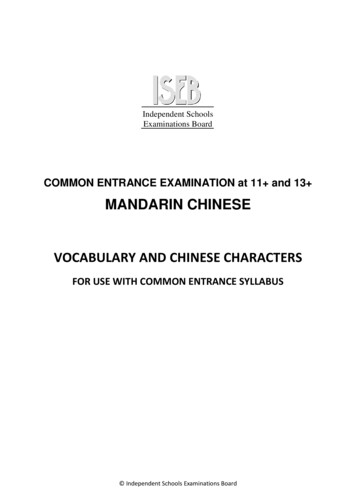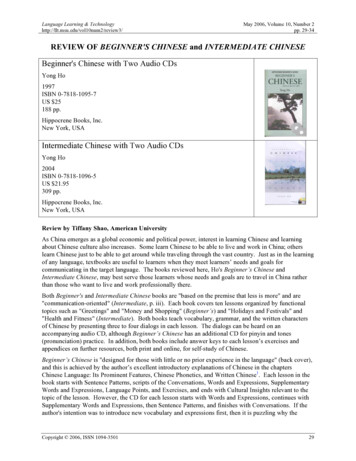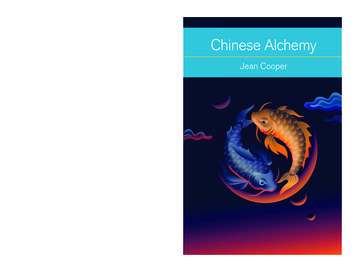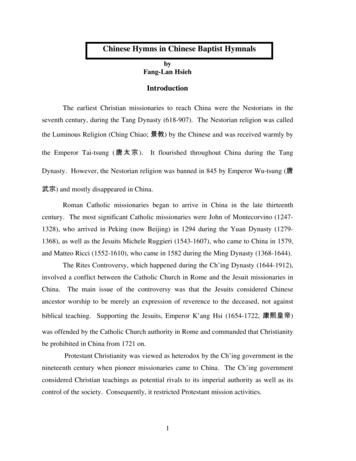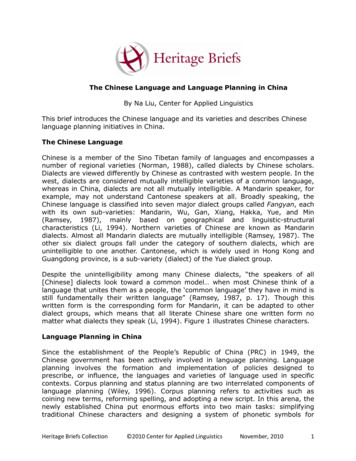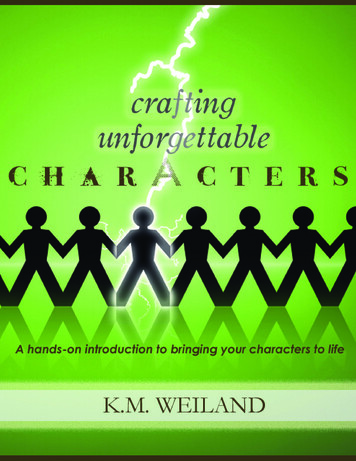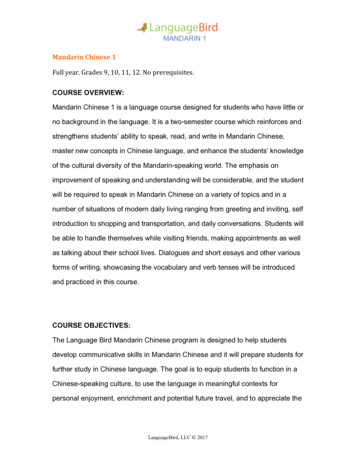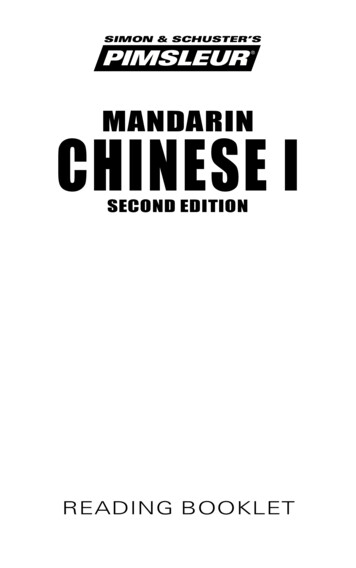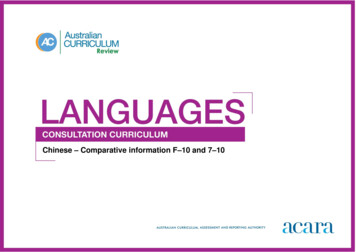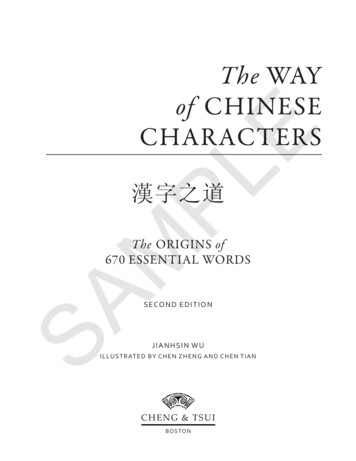
Transcription
PLEThe WAYof CHINESECHARACTERS漢字之道SAMThe ORIGINS of670 ESSENTIAL WORDSSECOND EDITIONJIANHSIN WUI L L U S T R AT E D B Y C H E N Z H E N G A N D C H E N T I A NCHENG & TSUIB O S TO N
Copyright 2016 by Cheng & Tsui Company, Inc.Second EditionPLEAll rights reserved. No part of this publication may be reproduced or transmitted in any form orby any means, electronic or mechanical, including photocopying, recording, scanning, or anyinformation storage or retrieval system, without written permission from the publisher.23 22 21 19 18 17 16 151 2 3 4 5 6 7 8 9 10Published byCheng & Tsui Company, Inc.25 West StreetBoston, MA 02111-1213 USAFax (617) 426-3669www.cheng-tsui.com“Bringing Asia to the World”TMISBN 978-1-62291-046-5SAMIllustrated by Chen Zheng and Chen TianThe Library of Congress has cataloged the first edition as follows:Wu, Jian-hsin.The Way of Chinese characters : the origins of 400 essential words [Han zi zhi dao] / byJianhsin Wu ; illustrations by Chen Zheng and Chen Tian.p. cm.Parallel title in Chinese characters.ISBN 978-0-88727-527-21. Chinese characters. 2. Chinese language--Writing. I. Title. II. Title: Han zi zhi dao.PL1171.W74 2007808’.04951--dc222007062006Printed in the United States of AmericaPhoto Creditsfront cover Fotohunter/ShutterStock
PrefacePLECONTENTSBasic RadicalsNumeralsv117Characters by Pinyin (A-Z)A - FG - KSAML - R2165106S - W143X - Z180IndexesCHARACTER INDEX by Integrated Chinese Lesson227CHARACTER INDEX by Pinyin239CHARACTER INDEX: TRADITIONAL by Stroke Count251CHARACTER INDEX: SIMPLIFIED by Stroke Count263
ABOUT the AUTHORreceived her Ph.D from the Department of East Asian Languages and Literaturesat University of Wisconsin, Madison. A professor of Chinese at Pomona College since 1990, sheconcentrates her research on etymology, the pedagogy of teaching Chinese to heritage students,classical Chinese novels, and modern Chinese poetry.SAMPLEJIANHSIN WUivThe Way of Chinese Characters
PREFACEPLEMastering characters is often the most challenging task for learners of Chinese. Unlike an alphabeticallanguage with a writing system composed of a limited number of letters, the Chinese writing system isbuilt upon about 200 radicals, which are the most basic components of Chinese characters. (Radicals,along with stroke counts, also provide the organizing principle for Chinese dictionaries.) Althoughthere are over 50,000 Chinese characters, 2,500 characters are required for basic literacy. Furthermore, the pronunciation of a particular character does not necessarily relate to its meaning. The sheernumber of Chinese characters, in addition to the frequent lack of visual pronunciation guides, makescharacter memorization a significant challenge for many.Paradoxically, this complexity is precisely what draws many people to learn Chinese. The presenceof pictographic elements in Chinese characters is one of the unique and fascinating aspects of thelanguage. Most radicals, for example, are pictographs, or visual representations of objects or concepts.Given a pictograph, learners can turn the character into a vivid picture, or associate the characterwith a shape, color, sound, smell, feeling, emotion, movement, or action. When using this methodof employing pictographs as memory aids, students will find that learning Chinese characters can beenjoyable, and can provide valuable insight into Chinese culture.SAMWe believe that each and every Chinese character is a crystallization of the wisdom and creativityof our ancient Chinese ancestors. When given the logical and historical origins of each character, asdescribed in this book, learners can also remember characters in an efficient and intelligent manner,rather than mechanically reproducing strokes that may seem meaningless to them. Students can alsoacquire knowledge of Chinese history and culture while learning the origins and evolution of characters, as their pictographic features often reflect vivid aspects of ancient life, such as agricultural anddomestic life, war, trade materials, crafts, rituals, etc.After studying The Way of Chinese Characters, learners will understand pictographic forms, interpretthe logic behind the meanings of characters, and know something about the ancient forms of the mostcommonly occurring characters.WHAT’S NEW IN THE SECOND EDITION?The second edition of The Way of Chinese Characters includes over 220 more characters than the firstedition. It now covers all the characters in both Part 1 and Part 2 of Integrated Chinese Level 1. Thebook has also been redesigned to be easier to read and carry, and reordered alphabetically by pinyinto make it easier to find characters. New example words and phrases have been added to each entry tohelp students learn how each character is used.The Way of Chinese Charactersv
SELECTION AND PRESENTATION OF CHARACTERSThe 670 characters included in this book are frequently used in modern Chinese, and cover all thecharacters in the glossary of Integrated Chinese, Level 1, Part 1 and Level 1, Part 2 (by Yuehua Liu,Tao-chung Yao, et. al.), the Chinese textbook most widely used at schools across the United States.Explanations are given in both English and Chinese. The English entries are meant for beginning andintermediate students, while the Chinese entries may serve as references for teachers and advancedlearners.PLEFor each entry, we display the character in its various ancient scripts (see Types of Script below),and we include each character’s classification, which indicates how the character was constructed (seeTypes of Characters below). Most characters have illustrations that help readers instantly connect thecharacters’ pictographic elements to their meanings, both ancient and modern. Some characters arenot accompanied by illustrations. Many of these are pictophonetic characters that have developedmeanings largely unrelated to their visual aspects.Also included are four indexes, organized alphabetically by pinyin, by Integrated Chinese lesson, andby stroke count (of both traditional and simplified characters), respectively. We hope all readers willfind these indexes convenient and practical.TYPES OF SCRIPTSAMK E Y TO S C R I P T T Y P E SSYMBOLSCRIPTOracle-BoneInscriptions篆Seal ScriptBronzeInscriptions草Cursive ScriptSYMBOLSCRIPT甲金EXAMPLES (報 )EXAMPLES (報 )The characters in The Way of Chinese Characters are written in “Regular Script” (or traditional characters) and simplified characters. Regular Script can be traced to the late Han Dynasty (207 b.c.–220a.d.) and is still used in Taiwan, Hong Kong, and many overseas Chinese communities. Simplifiedcharacters were introduced and promoted by the government of the People’s Republic of China in the1950s, and have since remained the standard in mainland China.In this book we focus on Regular Script, or traditional form, because we have found that it is oftendifficult for beginning learners to appreciate the visual flavor of simplified Chinese characters. Wepresent the ancient forms of the characters and provide illustrations, so that students can identifycharacters’ original pictographic traits. We hope that with such imagery in mind, students will have amuch easier time remembering Chinese characters.This book also introduces other forms of Chinese script including “Oracle-Bone Inscriptions 甲骨文,”“Bronze Inscriptions 金文,” “Seal Script 篆文,” and “Cursive Script 草書.” “Oracle-Bone Inscriptions”viThe Way of Chinese Characters
PLEcome from carvings on ox bones or tortoise shells, which were used during the Shang Dynasty(ca.1600–ca.1100 b.c.) to record events and devise predictions. “Bronze Inscriptions” are found onbronze vessels of the Shang and Zhou Dynasties (Zhou Dynasty: ca. 1100–ca. 221 b.c.). “Seal Script”includes both “Big Seal Script” and “Small Seal Script.” The former was used in the Qin State duringthe Eastern Zhou Dynasty (ca. 770–ca. 221 b.c.) and the latter became official in the Qin Dynasty(221–207 b.c.). As an abbreviated form of traditional Chinese characters, “Cursive Script” originatesfrom the Han Dynasty (207 b.c.–220 a.d.). These characters are written swiftly such that the strokesflow together, and were thus considered an artistic form of Chinese calligraphy. Many of the simplified characters used in mainland China today were born out of this cursive style.In the book, we display each character in its various forms: Oracle-Bone Inscriptions, Bronze Inscriptions, and Seal Script, alongside Regular Script and simplified forms. You will notice that some characters are without ancient forms, however, such as 她 (tā, she), 您 (nín, polite form of the pronounyou), and 啤(pí, beer), as these were created in later periods. Cursive Script is also shown for thosesimplified characters which were derived from the cursive style.TYPES OF CHARACTERSSAMChinese characters are constructed differently from alphabetic languages. According to the Handynasty scholar Xu Shen, in his Analysis and Explanation of Characters, they can be divided into sixbasic categories: pictographs (象形), explicit characters (指事), associative compounds (會意), pictophonetic characters (形聲), mutually explanatory characters (轉注), and phonetic loan characters(假借).Pictographs delineate the shape of certain objects or their parts. Examples include: 木 (mù, wood;tree), 刀 (dāo, knife), 女 (nǚ, woman), and 馬 (mǎ, horse). Although such characters are relatively easyto identify, the limitation of this particular category is that pictographs cannot convey more abstractmeanings.Explicit characters are simple diagrammatic indications of abstract ideas, such as 上 (shàng, above), or下 (xià, below). Others are formed with the addition of a symbol to an existing pictograph, such as 本(běn, root; basic), or 刃 (rèn, edge). Explicit characters constructed via this method comprise only asmall proportion of all Chinese characters.The meanings of associative compound characters are derived from their components, which maycombine two or more ideographs. Examples include 明 (míng, bright, the combination of 日rì, sun and月yuè, moon), and 森 (sēn, forest, the combination of three trees 木 mù).The majority of Chinese characters are pictophonetic, which combine semantic and phonetic components. For instance, the character 媽 (mā, mother) consists of 女 (nǚ, female) and 馬 (mǎ, horse). 女suggests the general meaning of the character while 馬 signals its pronunciation.According to Xu Shen, mutually explanatory (or synonymous) characters refer to those that are ofthe same or similar meanings, and thus can be used to define one another, e.g., 老 (lǎo, old; aged) andThe Way of Chinese Charactersvii
考 (kǎo, aged; long life; test). However, the exact meaning of this category is ambiguous. Some con-temporary scholars consider that the characters in this category actually refer to those later inventedcharacters for recovering their original meanings. A common way to make this type of character isto add radicals or other components to the original characters. The character 蛇 (shé, snake) is anexample from this category. The character 它 (tā) was a pictograph of a cobra-like snake and originallymeant “snake”. Later 它 was borrowed to mean “other,” “it,” etc., and these meanings overwhelmed itsoriginal meaning. Therefore, a worm radical 虫 was added to the left of 它 to make a new character 蛇.PLEPhonetic loan characters refer to those that originally had no written form, and so borrowed existingcharacters of the same or similar pronunciation. For example, the character 我 resembles a weaponwith a saw-toothed blade and long shaft, and originally referred to a kind of ancient weapon. Becausethe pronunciation of this character is similar to that of the pronoun “I,” 我 was borrowed to mean “I”or “me.”USING THIS BOOK AS A TEACHING TOOLSAMThis book is the result of a serious, meticulous, and extensive study of the origins of Chinese characters. Many of the books currently on the market on this topic offer learners imaginative, yet inaccuratepictorial representations of characters. While imagination can help learners remember Chinese characters, such historically groundless explanations may misinform them. This book’s academic, accurate,and straightforward explanations allow learners to study Chinese characters thoughtfully, but without the risk of becoming overwhelmed by overly detailed information on origin and evolution.It is our belief that this book will provide teachers with a new, efficient, interesting, and scholarly wayto teach Chinese characters to learners of Chinese, as well as learners of Japanese and Korean, whosewriting systems employ Chinese characters.The characters in this edition have been organized by pinyin for easy and universal reference, withseparate sections for some Basic Radicals and numerals. New students of Chinese should first familiarize themselves with these radicals and numerals, as they will make learning more complex characterseasier. Multiple indexes have been provided to help students and teachers look up specific characters.USING THIS BOOK WITH INTEGRATED CHINESEThe Way of Chinese Characters contains all the characters taught in Integrated Chinese Level 1 Part 1and Level 1 Part 2. Students of Integrated Chinese should use the “Character Index by IntegratedChinese Lesson” to easily find each character grouped by lesson as they proceed through the course.It is our expectation that this book will benefit all learners of Chinese characters, especially those whohave difficulty memorizing numerous characters. In short, we hope that reading The Way of ChineseCharacters helps learners overcome the obstacles to memorizing Chinese characters in an academicallysound and creatively engaging way.Jianhsin WuviiiThe Way of Chinese Characters
BIBLIOGRAPHYGu, Yankui 谷衍奎, ed. Hanzi yuanliu zidian《漢字源流字典》. Beijing: Huaxia chubanshe, 2003.Hanyu dazidian bianji weiyuanhui 漢語大字典編輯委員會, ed. Hanyu dacidian 《漢語大字典》.Chengdu: Sichuan cishu chubanshe & Hubei cishu chubanshe, 1993.PLEJiang, Lansheng 江藍生 and Zunwu Lu 陸尊梧, eds. Jianhuazi fantizi duizhao zidian 《簡化字繁體字對照字典》. Shanghai: Hanyu dacidian chubanshe, 2004.Jiang, Shanguo 蔣善國. Hanzixue 《漢字學》. Shanghai: Shanghai jiaoyu chubanshe, 1987.Liu, Yuehua 劉月華 and Yao, Tao-chung 姚道中, et. al. Integrated Chinese 《中文聽説讀寫》, Level 1,Part 1 Textbook. 3rd ed. Boston: Cheng & Tsui Company, 2009.Liu, Yuehua 劉月華 and Yao, Tao-chung 姚道中, et. al. Integrated Chinese 《中文聽説讀寫》, Level 1,Part 2 Textbook. 3rd ed. Boston: Cheng & Tsui Company, 2009.Rong, Geng 容庚, ed. Jinwen bian 《金文編》. Beijing: Zhonghua shuju, 1985.Shi, Dingguo 史定國, et al., eds. Jianhuazi yanjiu 《簡化字研究》. Beijing: Shangwu yinshuguan, 2004.Wan, Zhiwen 宛志文, et al., eds. Gujin hanyu changyong zidian 《古今漢語常用字典》. Wuhan: Hubeirenmin chubanshe, 2002.SAMWeng, Zhifei 翁志飛, et al., eds. Xinbian caoshu zidian 《新編草書字典》. Hangzhou: Zhejiang gujichubanshe, 2005.Xie, Guanghui 謝光輝, et al., eds. Hanyu ziyuan zidian 《漢語字源字典》. Beijing: Beijing daxue chubanshe, 2002.Xu, Shen [漢] 許慎. Shuowen jiezi 《說文解字》. Beijing: Zhonghua shuju, 1978.Xu, Shen. Preface to Analysis and Explanation of Characters in Zang, Kehe 臧克和 and Ping Wang 王平,ed. Shuowen jiezi xinding 《說文解字新訂》. Beijing: Zhonghua shuju, 2002.Xu, Zhongshu 徐中舒, et al., eds. Hanyu guwenzi zixingbiao 《漢語古文字字形表》.Chengdu: Sichuan renmin chubanshe, 1981.Xu, Zhongshu 徐中舒, et al., eds. Jiaguwen zidian 《甲骨文字典》. Chengdu: Sichuan cishu chubanshe, 1998.Zhang, Shuyan 張書岩, et al., eds. Jianhuazi suyuan 《簡化字溯源》. Beijing: Yuwen chubanshe, 2005.The Way of Chinese Charactersix
BASIC RADICALSare components of Chinese characters which often indicate the character’s meaning. Theyare useful to know not only because they can provide clues to the meanings of characters, but alsobecause many Chinese dictionaries are organized by radicals. Most radicals are common characters(often pictographs) and can be used on their own in addition to being components in more complicatedcharacters like associative compounds and pictophonetic characters. When used as components, radicalsmay appear in variant forms. For example, 心 (heart) may appear as 心 or 忄 in compound characters.PLERADICALSSee the “Types of Script” section on page vi of the Preface for more information about the different scripts.PICTOGRAPHIn the Oracle-Bone and BronzeInscriptions, the character 人 presents the profile ofa person with a head, an arched back, arms and legs,possibly indicating a figure from an early stage of humanevolution. In Regular Script, 人 looks like someonewith two rather long legs. As a radical, 人 often appearsas 亻, and is often used in characters related to humanbeings and their activities, e.g., 你 (nǐ, you), 他 (tā, he;him), 住 (zhù, to live), and 休 (xiū, to rest).人rénSAMman; person甲金刀dāoknife甲篆The Way of Chinese Characters篆人民客人rénmínkèrénthe peoplevisitor; guest; customer人們病人rénmenbìngrénP I C T O G R A P H In ancient writing systems, the character刀 resembles a knife, with the upper part as the handleand the lower part as the edge. In Regular Script,the handle is shortened so that it becomes almostunnoticeable. Characters with the knife radical刂usually have something to do with knives or cutting,such as 別 (bié, to separate), 刺 (cì, to stab), and 利(lì, sharp).刀子剪刀dāoziknifescissorsjiǎndāo人 �刃開刀people; the publicsick person; patient刀 �刀背。dāorènkāidāoknife bladeto perform or have an operation1
P I C T O G R A P H In both the Oracle-Bone and BronzeInscriptions, the character 力 resembles an ancientplow, with the upper part as the handle and the lowerpart as the plowshare. Since plowing requires greatphysical strength, 力 means “strength.” In RegularScript, 力 is similar in form to 刀 (dāo, knife) exceptthat its top sticks out.力lì甲金PLEpower; �力jīnglìyòuSAMright hand; again金nénglìyǒulìP I C T O G R A P H In its ancient form, the character 又 wasshaped like a right hand, meaning “right hand.” Today又 is used to mean “again,” “also,” “in addition,” “both and ,” etc.又甲力 �耕田要有力,引申為力氣。篆又及 yòují P.S.; postscript又 又 yòu yòu both and 又名kǒu又 象形。甲骨文像右手形。yòumíngP I C T O G R A P H The character 口 looks like an openmouth. Characters with the mouth radical are oftenassociated with the movement of the mouth, e.g., 吃(chī, to eat), 喝 (hē, to drink), 唱 (chàng, to sing), and叫 (jiào, to shout).口capability; abilitystrong; powerful; vigorousa.k.a.; alternative name口 象形。像人口形狀。mouth; stickdoorway口語人口kǒuyǔrénkǒuspoken language; vernacular languagepopulationThe Way of Chinese Characters
囗wéi篆P I C T O G R A P H In the Oracle-Bone Inscriptions, theupper part of 土 represents a small hill or mound of soil,while the bottom line stands for the ground. In RegularScript, a cross replaces the mound.土tǔSAMearth; soil甲金囗 �邊界。PLEencloseRADICALSP I C T O G R A P H 囗 represents the periphery or border ofan area. Characters relating to boundaries often includethe radical 囗, such as 國/国 (gúo, country; state),園/园 (yuán, garden; park), 圖/图 (tú, map). Note that囗 is larger than the radical 口 (kǒu, mouth), indicatinga large area that can contain many objects.篆土地土氣tǔdìtǔqìland; soilrustic; unsophisticated國土土豆P I C T O G R A P H In its ancient forms, the character 夕resembles a half moon, meaning “sunset,” “dusk,”“evening,” or “night.” Sometimes the moon can be seenrising from the east at dusk.夕土 象形。像一土塊狀,下方 �s territory; national landpotato夕 �xīsunset; evening甲金The Way of Chinese Characters篆夕陽 xīyáng sunset; the setting sun除夕 chúxī lunar New Year’s Eve前夕朝夕qiánxīzhāoxīeve; the day beforemorning and night; all the time3
PICTOGRAPHIn the ancient writing systems, thecharacter 大 portrays a figure standing with armsstretching out and legs spread apart. This posture seemsto suggest that humans are the greatest creatures onearth. The primary meanings of 大 are “big,” “large,”“great,” “age,” and “older.”dàbig; ; grown-upall; everyonenǚSAMfemale;woman金金zǐbaby; child4金dàxué女人女生nǚrénwomanfemale student; girlnǚshēng篆孩子房子háizichildhouse; buildingfángzi女兒女士兒子餃子college; universitygrow upzhǎngdà女 �跪形。nǚ’érnǚshìP I C T O G R A P H In its ancient form, the character 子shows a baby swaddled in cloth, with its head stickingup and arms stretching out. In Regular Script, the headof the baby is represented by a horizontal hook insteadof a round shape. 子 is used as suffix after some nouns,such as 桌子, 椅子 etc.子甲大學長大P I C T O G R A P H In the Oracle-Bone Inscriptions, thecharacter 女 depicts a woman kneeling with her armslowered and hands clasped on her lap, reflecting thelower social status of women in ancient times. In laterforms, the kneeling component is transformed aswomen are recognized as having a status more equal tomen. The Regular Script forms of 女 and 大 are similar,but 女 emphasizes the female bosom.女甲大 terlady; madam子 �褓中的嬰兒。sondumpling; pot-stickerjiǎoziThe Way of Chinese Characters
寸cùnRADICALSE X P L I C I T C H A R A C T E R In Seal Script, 寸 combines 又with 一. 又 means “right hand” while 一 indicates thesection of the forearm one inch from the wrist, where atraditional Chinese doctor would feel a patient’s pulseand diagnose ailments.寸 ��PLEinch尺寸 chǐcùn size; dimension; measurement寸口 cùnkǒu a person’s pulse on the wrist寸步難行 cùnbù nánxíng unable to move a single step (idiom)篆A S S O C I AT I V E C O M P O U N DIn the Oracle-Bone andBronze Inscriptions, the character 小 consists of threedots, like three tiny grains of sand. In its later forms, 小resembles a knife (represented by the vertical hook inthe middle) cutting something into two smaller xiǎoháirchild; kid; kiddyxiǎo shíhou in one’s childhood小學小姐小 ̌ojiePICTOGRAPHIn the ancient writing systems, thecharacter 工 looks like a carpenter’s square or ruler. Theoriginal meaning of 工 was “tool,” from which derivedthe meanings “work,” “labor,” “skill,” “craftsmanship,”and “construction project.”工gōngelementary/primary schoolMiss; young lady工 象形。像工匠用的曲尺。tool; work; labor甲金The Way of Chinese Characters篆工具工作gōngjùtoolto work; ; engineering projectgōngchéng5
PICTOGRAPHIn the Oracle-Bone and BronzeInscriptions, the character 幺 represents a wisp of silk.Since a wisp is a small quantity, 幺 extends to mean“small,” “tiny,” or “youngest.”幺yāo甲金PLEtiny; small幺 yāo one (spoken form when spelling out numbers, esp. on telephone)老幺 lǎoyāo youngest篆P I C T O G R A P H In the Oracle-Bone Inscriptions, thecharacter 弓 resembles an entire bow. In the BronzeInscription form, 弓 depicts a bow without its string,which is how a bow should be stored. Just like humanbeings, bows need time for 金gōngjiànbow and arrow彈弓篆心理擔心xīnlǐpsychology; mentalityworry; to be anxiousdānxīn弓 �。金文簡化。dàn’gōngP I C T O G R A P H In its ancient forms, the character 心represents a heart. There are two forms of the heartradical, 心 and 忄. 心 is usually positioned at the bottomof a character as in 想 (xiaˇng, to think) and 愁 (chóu, toworry), while 忄is on the left, as in 忙 (máng, busy) and怕 (pà, fear). Characters with heart radicals are oftenassociated with feelings or other mental activities.心甲幺 ��,不同的是糸為一束絲, 絲為兩束絲。系(xì) �心情catapult; slingshot心 象形。像人的心臟。guānxīnxīnqíngcare for; be concerned withmood; state of mindThe Way of Chinese Characters
NUMERALSyīonePLE一There is a Chinese joke about a silly boy who beganto learn numerals. After the boy learned 一,二,三 from his teacher, he told his father he was able towrite any number. His father was very proud. One dayhe asked his son to write the number “ten thousand” toshow his guests. The boy remained worked for half a day,but was still unable to finish the task. When the guestssaw what he wrote, they all laughed. On the paper werethousands of horizontal strokes! In fact, numbers largerthan three are expressed in a different 篆一直 yìzhí straight forward; continuously; always一點兒 yīdiǎr a little; a bit二胡 èrhú two-stringed Chinese instrument二百五 èrbǎi wǔ idiot; stupid person三角 sānjiǎo triangle三明治 sānmíngzhì sandwichSAM甲P H O N E T I C LO A N C H A R A C T E R In the Bronze Inscriptions, the character 四 resembles a big nose, or nostrilson a face. Therefore it originally meant “gasp” or “pant.”Later 四 came to mean the numeral “four.” In the Oracle-Bone inscriptions, “four” was represented by fourhorizontal lines, but this character was replaced by 四.四sìfour甲金The Way of Chinese Characters一 二 三 �原始的計數符號。NUMERALSIn Chinese writing systems,one horizontal stroke represents the number one, twohorizontal strokes stand for the number two, and threestrokes for the number three. 一,二,三 are probably the easiest Chinese characters to remember. Fromancient times until now, these three characters have notchanged much.EXPLICIT CHARACTERS篆四 ��字,因讀音相近而借用為四字。四方 sìfāng the four directions; all sides 四季 sìjì four seasons四面八方 sìmiàn bāfāng in all directions; all around; far and near17
E X P L I C I T C H A R A C T E R In the Neolithic signs around4,000 b.c., the symbol “X” was used to indicate “five.”In the Oracle-Bone and Bronze Inscriptions, a line wasadded above and below the X. In Regular Script, themiddle part of 五 resembles a cross that corners at itsright íngfive sense organs (nose, eyes, lips, tongue, ears 鼻目口舌耳); facial featuresfive elements of Chinese philosophy (wood, fire, earth, metal, water 木火土金水)P H O N E T I C LO A N C H A R A C T E R In the Oracle-Bone andBronze Inscriptions, the character 六 outlines a hut orshed, possibly some sort of prehistoric dwelling. Later,六 came to indicate the number six. In Regular Script,六 still resembles a simple house, with the roof on topand two pillars ��千liùbǎiliùqiānsix hundred6,000六萬六億六 ��六字。liùwànliùyìE X P L I C I T C H A R A C T E R In the Neolithic, Oracle-Bone,and Bronze Inscriptions, 十 represented the numberseven. However, in Seal Script, 十 was used to mean“ten” and the vertical line of 十 was bent to mean“seven.” In Regular Script, you may still see similaritiesbetween 十 (shí, ten) and 七 (qī, seven), as 七 looks like十 with a tail.七甲五 �陶器上,X即五。 60,000600,000,000七 字,以區別于十。qīzuǐ bāshé“With seven mouths and eight tongues;”lively discussion with many talking at onceThe Way of Chinese Characters
P H O N E T I C LO A N C H A R A C T E R The character 八 suggestsis the act of dividing something into parts. Originallythe character did mean “to divide” or “to separate.”Later 八 came to mean the numeral eight.八bā八 eighteeneightyP H O N E T I C LO A N C H A R A C T E R In the Oracle-Bone andBronze Inscriptions, the character 九 looks like the posterior of an animal with a long tail, possibly a monkey.Hence, the original meaning of 九 was “behind” or“buttocks.” Later 九 came to mean the number nine.九jiǔSAMnine甲金篆shíten金The Way of Chinese 九十九月E X P L I C I T C H A R A C T E R In the Neolithic signs, as well asin the Oracle-Bone Inscriptions, one vertical line stoodfor ten, two lines for twenty and three for thirty. In theBronze Inscriptions, a circular dot was added in themiddle of the vertical line. Later, in Seal Script, this dotbecame a horizontal line, making the character for “ten”look like a t hundred九 �巴,是尻(kāo jiǔyuèninetySeptember十 一個結表示一个十。十字架 shízì jià cross; crucifix十分 shífēn very; extremely十全十美 shíquán shíměi perfect in every way 十字路口 shízì lùkǒu crossroads; intersection19
A S S O C I AT I V E C O M P O U N D In the Oracle-Bone Inscriptions, the upper part of 百 may represent a ruler and thelower part a grain of white rice 白, suggesting a long lineof rice grains. Meanings of 百 are “hundred,” “numerous,” and “all kinds of.”百bǎi甲金PLEhundred幾百 jǐbǎi several hundred; how many hundred百貨公司 bǎihuò gōngsī department store篆A S S O C I AT I V E C O M P O U N D In its ancient forms, the toppart of 千 is a person 人 and the bottom part a ten 十,implying that the maximal life span of ten persons is1000 years. The primary meaning of 千 is “thousand”and its extended meanings are “many,” “numerous,” etc.千qiānSAMthousand甲金百 百姓二百bǎixìngèrbǎiordinary peopletwo hundred千 ��千,引申義為很多、無數。千萬 qiānwàn ten million; millions and millions; to be sure成千上萬 chéngqiān shàngwàn thousands upon thousands篆Heavenly Stems and Earthly BranchesIn addition to these numerals, the Chinese also traditionally used two sets of numbers to count up to sixty: ten heavenlystems and twelve earthly branches. Together, they were used to count years, months, days, and hours. Today, the heavenlystems still often appear as ordinal numbers, choices in multiple choice questions, or as abbreviations of parties in legaldocuments (Party A, Party B, etc.). Many also commonly appear as components in more complex characters.T E N H E AV E N LY S T E M �jǐgēngxīnrénguǐT W E LV E E A R T H LY B R A N C H E nmǎochénsìwǔwèishēnyǒuxūhàiThe Way of Chinese Characters
CHARACTERS by PINYIN(A–Z)K E Y TO S C R I P T T Y P E SSYMBOLSCRIPT甲Oracle-BoneInscriptions金Bronze InscriptionsSYMBOLSCRIPT篆Seal ScriptEXAMPLES ( 報 )PLEEXAMPLES ( 報 )草Cursive Script阿ā(a prefix)ēSAMbig moundPICTOPHONETIC CHARACTERThe character 阿(pronounced ē) is made up of the mound radical 阝andthe phonetic element 可 (kě), originally referring to “abig mound.” Its extended meanings a
The 670 characters included in this book are frequently used in modern Chinese, and cover all the characters in the glossary of Integrated Chinese, Level 1, Part 1Level 1, Part 2 and (by Yuehua Liu, Tao-chung Yao, et. al.), the Chinese textbook most widely used at schools across the United States. Explanation
